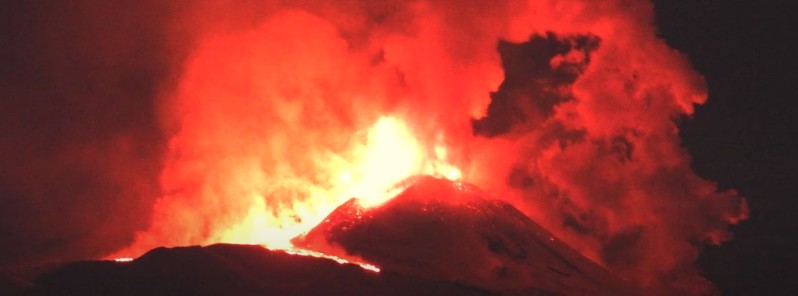Lava fountains at Etna on December 22, 2020


Strong strombolian activity and lava fountaining were observed at Etna's Southeast Crater on December 22, 2020, after dense cloud cover prevented initial clear observations of strong explosive activity that started on December 21.
At 01:30 UTC on December 22, the seismic network detected a sharp increase in the average amplitude of the volcanic tremor in the Southeast Crater, rising to high values.
Starting at 04:19 UTC, strombolian activity suddenly evolved into lava fountaining, feeding two distinct lava flows — one heading toward the southwest, branching west and east of Mount Frumento Supino, and the second heading eastward, inside the Bove Valley.
Analysis of surveillance camera images at 04:20 UTC revealed a small ground explosion in the Bove Valley, caused by the interaction of the lava flow and the snow cover.
Lava fountaining gradually subsided until it ceased at around 05:00 UTC.
Lava flow in Bove Valley has reached an estimated altitude of about 2 400 m (7 870 feet) at the time. The second lava flow was also still powered and the front stood at an estimated altitude of about 2 500 m (8 200 feet) a.s.l.
Volcanic tremor sharply decreased around 04:00 UTC, reaching average values. Infrasonic activity remained sustained and located mainly in the area of the Southeast Crater. Soil deformations monitoring networks no longer showed significant deformations.
In an update released at 16:38 UTC, INGV said lava flows were no longer being powered and have begun to cool. "Volcanic tremor exhibited modest fluctuations in the last few hours and currently stands at an average value."
Regarding infrasonic activity, there is a slight decrease in the number of infrasonic events; the sources are located mainly in the area of the Northeast Crater and, to a lesser extent, in the area of the Southeast Crater.
Soil deformations monitoring networks show no more significant deformations on high and medium-altitude station signals.
Featured image credit: Boris Behncke/INGV

Ivan, I am not surprised about your guess that the Djinns flatulating is responsible, and this notion is not far from the Black Holes and the rest of the myths. Do you know why I am not surprised? Because I am sure you are from the same tribe who invented the myths of the religions and all the current myths in science
Jamal: I’m sure that you have a much better theory to explain this than the heat generated by the radionuclides. So I guess, it must be the djinns flatulating incessantly in earth’s core?
In geophysics, it is well known that hotspot volcanoes, like the volcanoes of the Hawaiian Islands, Réunion, Yellowstone, Galápagos, Iceland and many others, are hotspots that are fed by narrow streams of hot mantle rising from the Earth’s core–mantle boundary in a structure called a mantle plume. In fact, currently the estimate for the number of hotspots postulated to be fed by mantle plumes has increased to several thousands, by many geologists.
Now, the question that one should ask, how can the temperature of the core of the Earth remain to be hotter than the surface of the Sun, taking into consideration that those volcanoes have been erupting for billions of years? In other words, if one takes into consideration the number of times hot spot volcanoes have erupted over the last 4.543 billion years how can the core of the Earth, remains to be hotter than the surface of the Sun? And, never mind about the rest of land volcanoes or the hundreds of thousands of submarine volcanoes.
I think conventional theories have no chance of answering this question, This question can only be answered by Al Gore-Greta Thunberg Theory. Hahahahahahahahaha